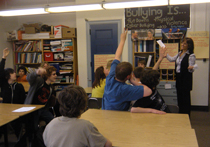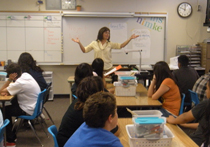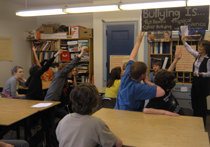 This is a story of one of your fellow teachers, turned Project ALERT (PA) Trainer, who went back to the classroom. You may be wondering why I would do such a thing, the answer is simple, well sort of…I did it because of you. When I say “you”, I mean for all those who I have trained in PA. It was your comments and remarks combined with my desire to be able to relate to the program and teachers I work with that drove the decision. It has been “too long“ since I have been the teacher in the classroom and throughout the many years that I have been a PA trainer, I know things have changed—you have told me that. After all, it is the No Child Left Behind (NCLB) era!
This is a story of one of your fellow teachers, turned Project ALERT (PA) Trainer, who went back to the classroom. You may be wondering why I would do such a thing, the answer is simple, well sort of…I did it because of you. When I say “you”, I mean for all those who I have trained in PA. It was your comments and remarks combined with my desire to be able to relate to the program and teachers I work with that drove the decision. It has been “too long“ since I have been the teacher in the classroom and throughout the many years that I have been a PA trainer, I know things have changed—you have told me that. After all, it is the No Child Left Behind (NCLB) era!Let me digress just a bit to give some context for the story. I have been a PA trainer for over 15 years. In fact, I may have trained you to use the program, or perhaps you have seen me on the training videos used in the workshops. Anyway, my work with Project ALERT is longstanding so I will give you the short version. Back in the late eighties when PA was under development with the RAND Corporation, I was one of the teachers invited to give critical feedback on the program. I was working on my doctorate at the time, so being able to participate in an evaluation of this caliber was quite appealing, along with the added bonus of working with the revered RAND. It was a wonderful experience and I valued being a part of the process. Once the program was demonstrated to be effective, it was further refined and packaged for distribution.
A few years passed, I finished my doctorate and was working as an education administrator. The BEST Foundation, who provides the support, distribution and training for PA, invited me to become a trainer. I loved the program and knew my students had responded favorably to it. Becoming a trainer for the curriculum was an easy decision.
By now I have trained hundreds of teachers and others from all over the country to deliver PA. I thoroughly enjoy working with educators. You are a wonderfully diverse and interesting group with a common thread of caring for kids and wanting them to be their best—and of course that means free from substance use. I find I often draw upon my previous teaching of PA in my trainings. This has allowed me to connect to the participants and gain credibility.
 We all know it takes a certain ability and skill to work with adolescents—some say being a bit “crazy” helps but I see it as a gift. This is the time of development where kids seem like they are on an emotional rollercoaster. Helping them to moderate those emotions and make healthy choices is a big part of what we do in preparing them for success. Over the years I have heard my middle school colleagues consistently say the best thing about working with middle school students is that they are still formative—my fellow educators believe that they can make a difference and that students listen to them. In a nutshell, they feel they still have a chance to positively impact the lives of their students in important and meaningful ways. I believe PA is a powerful vehicle to help us achieve this goal.
We all know it takes a certain ability and skill to work with adolescents—some say being a bit “crazy” helps but I see it as a gift. This is the time of development where kids seem like they are on an emotional rollercoaster. Helping them to moderate those emotions and make healthy choices is a big part of what we do in preparing them for success. Over the years I have heard my middle school colleagues consistently say the best thing about working with middle school students is that they are still formative—my fellow educators believe that they can make a difference and that students listen to them. In a nutshell, they feel they still have a chance to positively impact the lives of their students in important and meaningful ways. I believe PA is a powerful vehicle to help us achieve this goal.In the PA trainings I hear about how challenging it has become to teach programs such as PA. Reasons for this vary but tend to be that the required coursework is itself a heavy load, classes are crowded, students can be disrespectful and unruly and teachers are under constant pressure to focus on student performance on standardized tests. Thus, the perception of many is taking time to teach PA, or frankly any other topic not found on “the test”, is an unaffordable luxury. Most agree that youth desperately need the information and skills obtained in PA but feel at a loss to make time due to mandated priorities.
I taught pre-NCLB, in the days when teachers pretty much were told what subject they were to teach and then given lots of professional freedom to design and deliver the subject matter in the way they (the teacher) determined was best. I guess this is precisely why I thought it was time to return to class. I needed to experience (at some level) what it was like to be a teacher again, particularly in this new educational culture. My journey to reconnect with my teaching past begins…
I contacted some of my colleagues in a few schools in California, Oregon & Washington and was pleased at how accommodating and receptive they were to my request to teach PA. Within 3 days I was booked into their classrooms. As I was preparing for teaching, I went directly to the PA curriculum guide reviewing the lesson preparation section and the selected lesson. I logged onto the PA website projectalert.com to identify the lesson support and found the student handouts and other support materials available online. I had to get to an office supply store to buy paper and markers as I’d been warned that these are precious commodities in schools. When it was time to finalize my last minute arrangements I was thankful for email; I find teachers are really good about communicating in this format.
Coincidentally, the first school I was to teach at was the school I had ATTENDED as a middle school student. I had thoughts of the students seeing me as too old to relate to them. I was mindful of my appearance, as I know middle school kids are quick to size people up and draw conclusions. I asked my 16 year old daughter to give me fashion advice. Suffice to say, after much laughing, I was ready.
Although the trees were bigger and the surrounding community much more populated, the building lay out was the same as when I was a student there. I had a sense of familiarity that helped for my first venture back to class. I noticed immediately that this school and all the others had increased security procedures such as signing into the office and getting “badged”. This was followed by the front office staff calling the teachers I would be working with to let them know I had arrived.
 On this day I taught PA lesson #1 to 5 classes in a row with each class having about 35 students. I was scrambling between classes to get ready for the next one. A four-minute passing period left no time for prep. Also, the students were in close proximity to one another and that means lots of distraction. I must say there were a few notable discipline challenges that kept me constantly on my toes. I needed to keep things moving along to keep their attention. The minute I hesitated (as was the case when I struggled with an unfamiliar DVD player) they tended to drift. I probably don’t need to say this, but once kids get disengaged, it takes effort and time to get their attention back. The good news is I managed to finish the lesson in the allotted 50 minutes even with 6 work groups reporting out. Near the end of the day my voice was strained, I was hungry and had to use the restroom. I was exhausted and it was only my first trek back to class.
On this day I taught PA lesson #1 to 5 classes in a row with each class having about 35 students. I was scrambling between classes to get ready for the next one. A four-minute passing period left no time for prep. Also, the students were in close proximity to one another and that means lots of distraction. I must say there were a few notable discipline challenges that kept me constantly on my toes. I needed to keep things moving along to keep their attention. The minute I hesitated (as was the case when I struggled with an unfamiliar DVD player) they tended to drift. I probably don’t need to say this, but once kids get disengaged, it takes effort and time to get their attention back. The good news is I managed to finish the lesson in the allotted 50 minutes even with 6 work groups reporting out. Near the end of the day my voice was strained, I was hungry and had to use the restroom. I was exhausted and it was only my first trek back to class.I ended up teaching in four school districts in three different states. I taught 13 classes and observed in three more, delivering five different lessons in five schools. Nearly 350 students received instruction. Whew! Well as you can imagine, each class and school has its own interesting story, but rather than provide you with a travelogue, here are some things I learned:
Students
 Students are interested in the topic of substance use and have strong interest and curiosity—they know a lot about tobacco and alcohol and its effects (Lesson #1 and #2).
Students are interested in the topic of substance use and have strong interest and curiosity—they know a lot about tobacco and alcohol and its effects (Lesson #1 and #2).There is plenty of misinformation and some confusion about marijuana and its effects—possibly mirroring the larger societal debate about legalization and medical use. (Lesson #1 and #2).
Students seem to know about inhalants and have lots of scary misinformation thinking this is a low risk activity (Lesson #8).
Students tend to have someone in their family, or know someone close to them, who smokes cigarettes (Lesson #10).
The videos keep the students attention and are an important part of the curriculum to communicate information and set the stage for discussion and problem solving.
The older the student the more they appear to be set in their beliefs and seem less open to information that may be inconsistent with their beliefs.
Students are open to an “outsider” coming in to teach about this subject (Note: All teachers were in the class while I was teaching).
When asked on paper the most important reason not to use drugs, many stated something like, “it’s bad for you”, “it messes you up” or “it is stupid”. However in class among their peers, they displayed much less disdain for drug using behavior.
Most students indicated that learning about drugs from their teacher would help them NOT use drugs—THIS SHOULD BE AN INSPIRATION FOR ALL OF US.
Students are really bad about doing homework—there need to be incentives to get them to take it seriously.
Teaching
Being prepared for each class is essential to keep the flow. This typically means having charts labeled, posters out, videos queued up, seating conducive to group work and so on.
 Teaching the same content to 5 classes back to back is exhausting—particularly on the vocal cords and general enthusiasm. Having a break, snack and someone to cover while you run to the restroom is a blessing.
Teaching the same content to 5 classes back to back is exhausting—particularly on the vocal cords and general enthusiasm. Having a break, snack and someone to cover while you run to the restroom is a blessing.Smaller classes—around 20 students—are much easier to keep on task and allow for more interaction and Socratic teaching (probing, inquiry and understanding).
The PA lessons are engaging and provide a proven lesson frame but it is the enthusiasm of the TEACHER in conjunction with STUDENT PARTICIPATION that determines overall success.
Role-playing is a valuable tool to engage the learner; students like watching each other “perform”.
Learn and utilize, as appropriate, the language your students use to refer to the common drugs of abuse (i.e. pot, weed, kush). If you don’t know the answer to something tell them so—either they or you can look it up and respond later.
To keep focus and off-task behaviors to a minimum, lessons need to move at a brisk pace, students need to be engaged and a variety of teaching strategies need to be employed (this means you have to be prepared).
Having other teachers on site who teach PA facilitates the sharing of ideas, concerns, problem solving and support for one another. Connecting with others who are doing what we are doing enriches our teaching; we learn a lot from collaboration.
Well, there is more to tell but I have shared what I think is most relevant to you, my teaching colleagues. I leave this experience with an increased appreciation for what it takes to teach in today’s classroom. I am ever inspired by the joy of teaching and feel an increased commitment to making sure students learn about drugs and stay safe and drug-free!
Thanks to the teachers who welcomed me into their classrooms: Elizabeth Nimke, Jack Lee, Wayne Rickert, Cynthia Thomas, Bill Branvold, Kevin Olsen, Kristi Young, Peggy Solum and the administrators who helped make this trip so enlightening and successful. I wish you continued success in implementing PA. See you “Back in Class”! FONDLY, Pam

